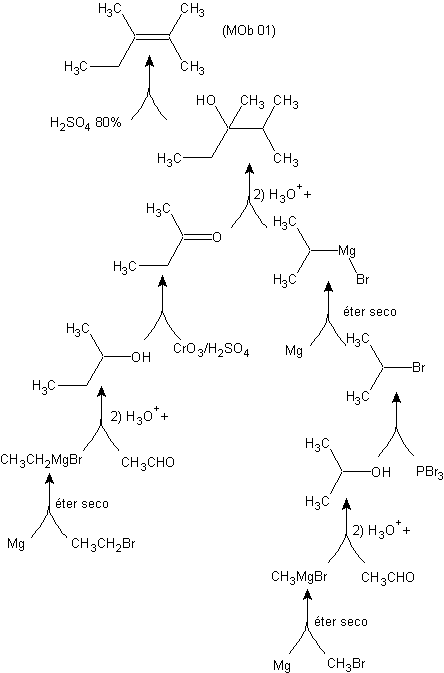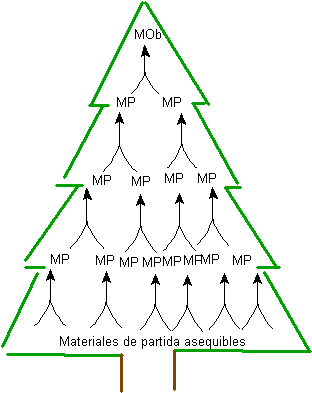The elaboration of a " synthesis tree " based on generating intermediate or precursor molecules, step by step in the antithetic direction (retrosynthesis), that is, starting from the objective molecule, constitutes a method that can be better understood by considering the following general principles of said process.
1. Start with the final structure (MOb). Starting from the final structure, the target molecule, work backwards (retrosynthesis) until easily accessible raw materials are obtained. If the starting raw material is specified in the synthesis problem, this only limits the number of possible synthetic routes to be addressed.
2. Characterization of the target molecule (MOb ). When examining the structure of the target molecule, it is necessary to answer the following questions:
to. What kind of compound is it?
b. What functional group(s) does it contain?
c. What is the nature of the carbon skeleton?
d. Does the molecule have a normal or branched alkyl chain?
and. Does it contain rings and are they cycloalkyl or aromatic?
F. Does the MOb have actual or potential symmetry?
3. The Functional Group . In this regard, it will also be good to answer the following questions:
to. Is the reactivity, sensitivity and instability of the functional groups that the MOb possesses known?
b. What general methods are available for its preparation?
c. Which of them is applicable to the specific functional group of the problem molecule?
4. Stereochemical aspects . It will be analyzed in the MOb, preferably:
to. chirality centers
b. Shaping and configuration of rings
c. Proximity effects between groups
5. The carbonate skeleton . The main problem in most organic syntheses is the construction of the carbon skeleton. The exchange of functional groups (IGFs) is often simple to do, such as ketone to alcohol, aldehyde to acid, or alcohol to bromide. The questions that are asked regarding the construction of CC links are related to those that have already been raised regarding the functional group.
to. Are some of the methods available to form functional groups applicable to generate CC links? If so.
b. Is the method compatible with the specific carbon skeleton of the target molecule? If it is not.
c. Is there a procedure for forming a carbon chain that produces a convertible function to the required one?
6. Precursor Molecules (PM)
The analysis of the structure of the problem molecule and the consideration of the questions posed in steps 1) to 5), will give rise to two possible types of precursor molecules. One of them contains a functional group equivalent to that of the final structure.
The other is a compound with fewer carbon atoms than the target molecule. When the latter are brought together, the final carbon chain and the required functionality are achieved.
The generation of any of these types of precursor molecule should result in a simplification of the problem.
In general, if a projected path leads to precursors that are more difficult to synthesize than the problem itself (target), another path must be sought.
Fig. 1. TREE OF SYNTHESIS
The generation of precursor molecules, up to reaching the starting materials, generates a series of structures, which together form a kind of tree, fig.1. This is where the name of the synthetic method comes from.
Application of the Synthesis Tree Method
Propose a synthesis design, starting from simple and affordable materials, for the following molecules:
MOb 01 : 2,3-dimethyl-2-pentene.
Solution.
MOb.01 is a non-symmetrical alkene and remember that the best substrates or precursors for alkenes are alcohols or alkyl halides, which form the corresponding alkene by elimination reactions.
Therefore, a good precursor molecule (or better substrate) for MOb 01 will be 2,3-dimethyl-3-pentanol, which, treated with concentrated sulfuric acid, will produce MOb 01.
This alcohol could have been prepared from other precursor molecules such as 2-butanone and a Grignard reagent, isopropyl magnesium bromide, which is obtained from isopropyl bromide with metallic Mg.
The required bromide is prepared from isopropyl alcohol and phosphorus tribromide.

